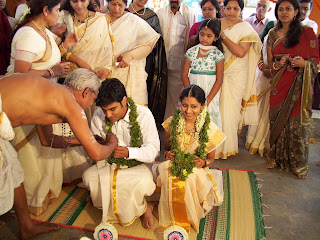
Tuesday, January 25, 2011
Simple Kerala Weddings !

I have been observing many Kerala Hindu marriages and found that some confusion always prevails.
Except Brahmin marriages I have not seen any vast difference in the rituals among various caste marriages and one thing is common “confusion”. Because it is simple people do not care for details or the sequence. In many cases some elderly person comes forward voluntarily and takes control. Then what he orders is considered to be the custom. Often the sequence is at his whims. So when another elder watches it ( who has not cared to come forward and lead ) interferes then the confusion starts. One Mr. S.R. Nair in his blog has put it as Karayogam rivalry. But I do not think so. Because in Malabar the NSS Karayogam or SNDP has no big role in people's lives. But the confusion still prevails.
I think the reason for this confusion is sheer ignorance and attitude. We do not learn from the past mistakes. People forget the event so soon and do not care until another marriage comes across. They overlook the lack of perfection and clarity in what they do.
The most important thing is that until the real marriage ceremony nothing is explained to anyone because it is always considered to be the most simple. Its so simple so what to learn? That’s the attitude. The Parents of the couple and the couple themselves have no clue of what’s going to happen or what’s going on.
Ever since my niece’s marriage in Nov.2009 I have been pondering on this problem. For my niece’s marriage I had prepared a Managalpatrika ( a poem to be read on the occasion ) Even that recital got buried in the confusion that preceded. So even when all other things were meticulously planned when the real moment came everything got fuzzy.
Recently I had a conversation with writer P.R.Nathan about this. According to him during the marriage FIVE things are done in the ritual and these have direct connection to Panchabhootas ( Five elements) .
Agni : ( FIRE ) The marriage performed in front of an agni kund ( fire pit) or Lamp
Jal : ( WATER ) The exchange of Ring ( anguleeyam or Ring has a relation with water )
Vayu : (AIR) Mangalasutra or Tali represents the Vayu
Akaash : (SPACE) Mala or garland represents akash – Pushpam ( flower ) has a relation with sky ( akaash)
Prithvi : (BHOOMI) Vastram – Pudava in Kerala
These are all present or exchanged as per various traditions. This denotes that we all belong to the panchbhootas. The body and the Kriyas et all.
Now I am not sure of each tradition. Having done some research on the matter (J) I wish to list out the procedure of a simple Kerala marriage as follows ( E & OE – pls. comment):
- The bridegroom dressed up in traditional Kerala attire arrives with near and dear ones and is welcomed by girl’s relatives.
- The bridegroom’s feet is washed by girl’s brother before entering the hall. ( Be prepared with a Kindi & Thorth- Traditional water vessel & towel.)
- The bridegroom is now showered with flowers and rosewater ( with Pananeerveeshi) and welcomed by young charming girls with Taalam. The mother of girl has a bigger taalam with ‘Ashtamangalyam’ in it ( enquire with a pooja stores for more details) – a Thookku vilakku holding person an elderly lady should walk in front followed by Ashatamangalyam holding person, and then the girls. With the nadaswaram accompanied the boy enters the hall and go around the Manatap once. Then comes towards the centre of the stage and bows to the audience and gets seated in the Mantap.
- Next the procession goes to bring the bride. The bride in traditional attire and bedecked with flowers is brought into the hall accompanied by Talam & Nadaswaram. She goes around the Manatap once, bows to the audience and gets seated on the left side of the bridegroom.
- The Poojari performs Tali pooja gives Prsadam to the couple.The groom & bride apply it, on self and on each other. ( If the poojari is not on Manatap the Tali pooja can be done in a
- Next the Poojari gives the Tali to the groom. He ties it. He is being helped by the girl’s relatives.
- Next the Ring is exchanged if it is not already exchanged. Some people exchange the Ring at engagement time and then for marriage it is avoided.
- Now the couple stands up and the Dakshina is given to poojari and the poojari blesses the couple.
- Next Pudava is given by the groom to the bride. The bride hands over the Pudava to her relatives.
- Next the garlands and the bouquet are exchanged.
- At this time the relative of both parties shower the couples with flowers and blesses them.
- Next the Kanyadanam is performed. The bride's father gives her hand and places it on the groom's hand symbolically transferring her responsibility to the bridegroom. ( in the Vedic times the boy has to recite Mameya mastu poshya: - She will be looked after by me alone. )
- Holding the hands the groom & bride rounds the the Mantap three times.
- Now the couple are blessed by relatives by sprinkling rice & flower on their head.
- The marriage ceremony with this is over.
- Now the relatives can give ‘Paalum Pazhavum’ ( Milk & fruit ) to couple.
- Photo session follows and the crowd moves for dinner.
I have just narrated the sequence as I have traced it and after some discussions. Please suggest/Comment if you know any better way.
Subscribe to:
Posts (Atom)